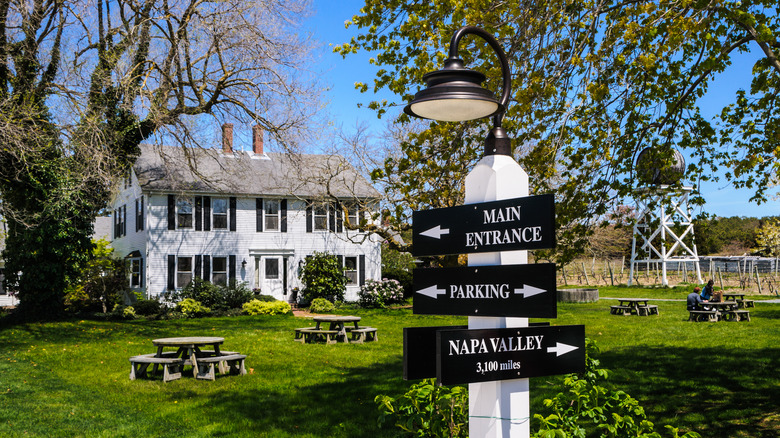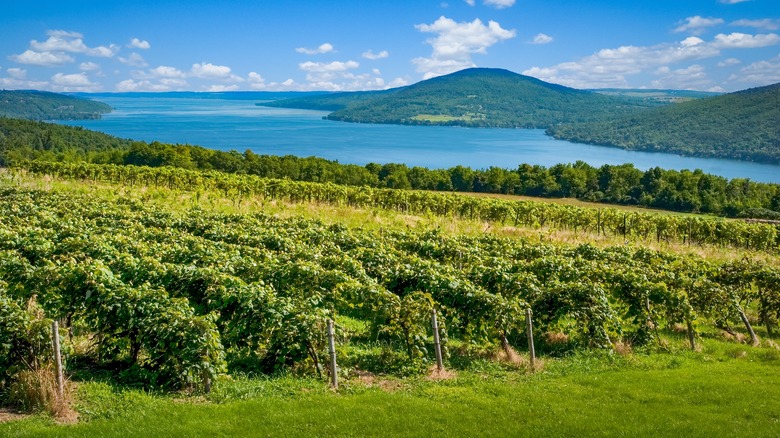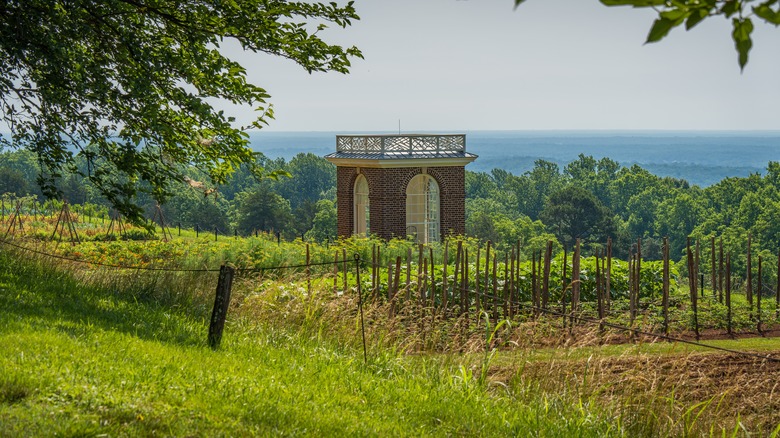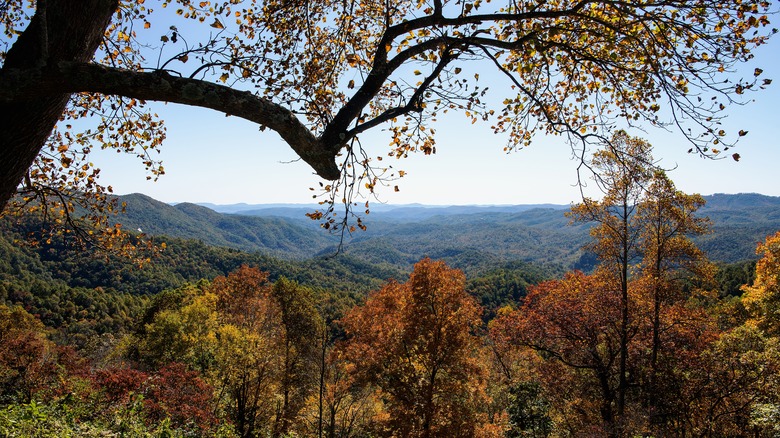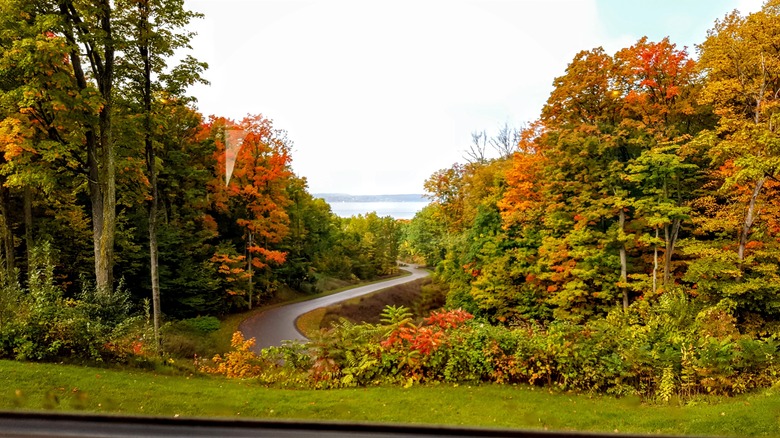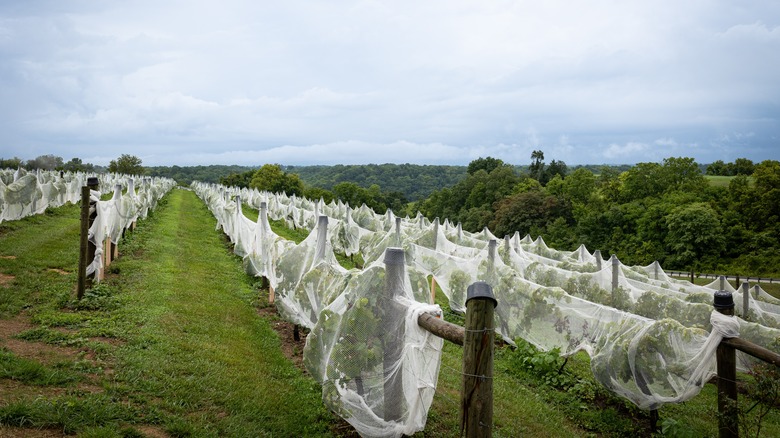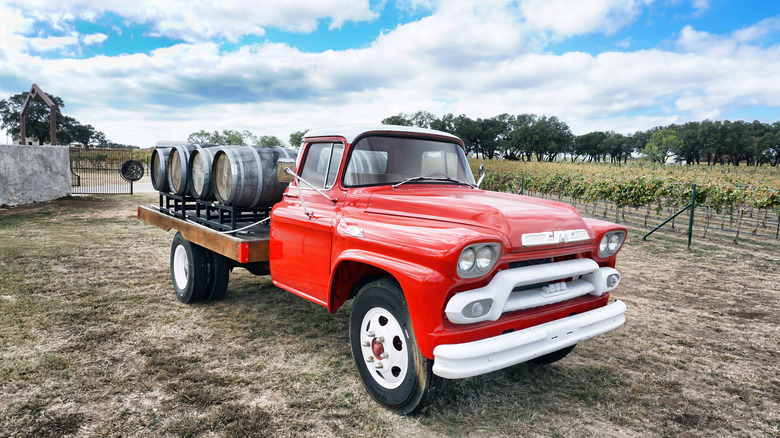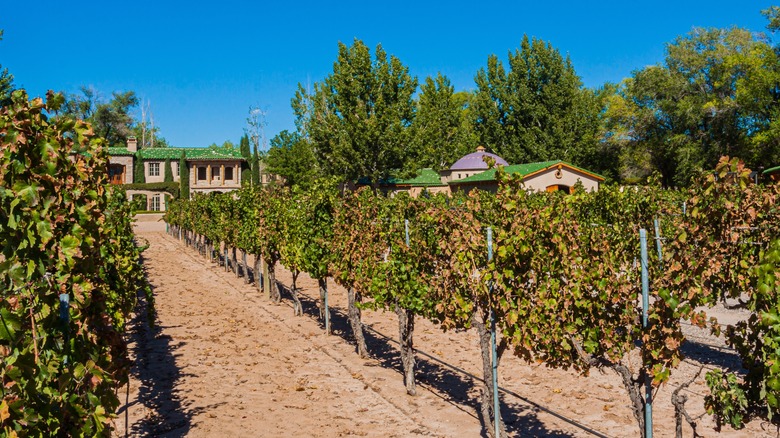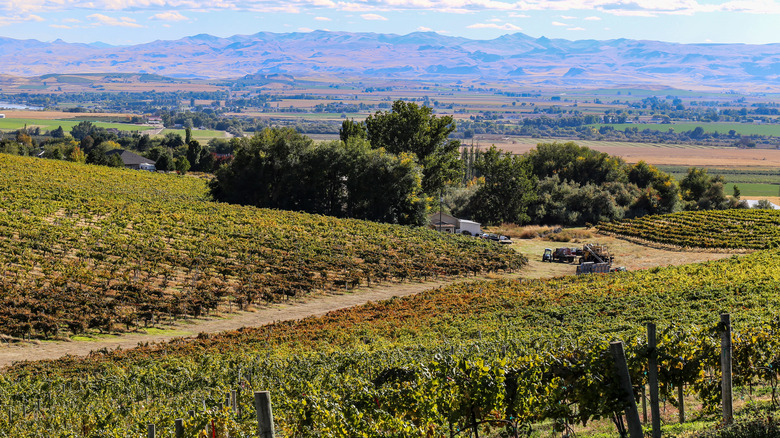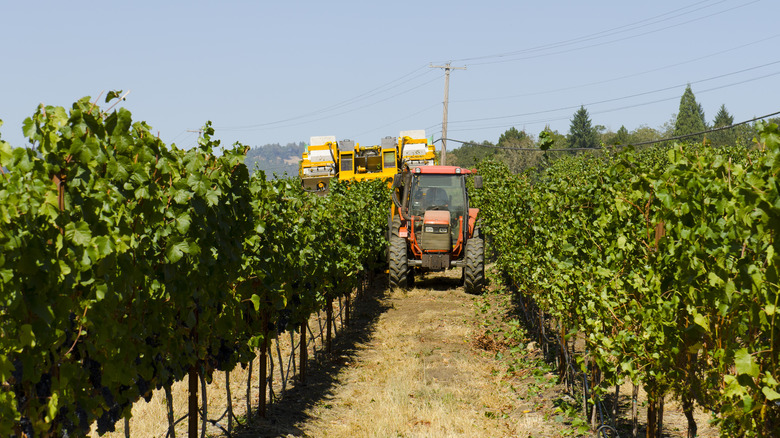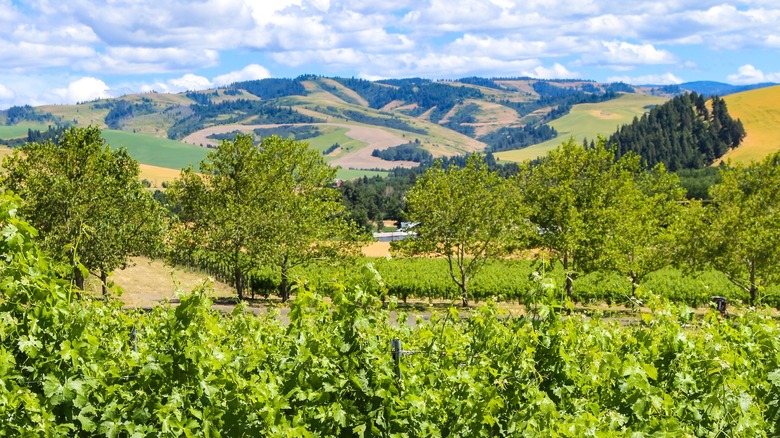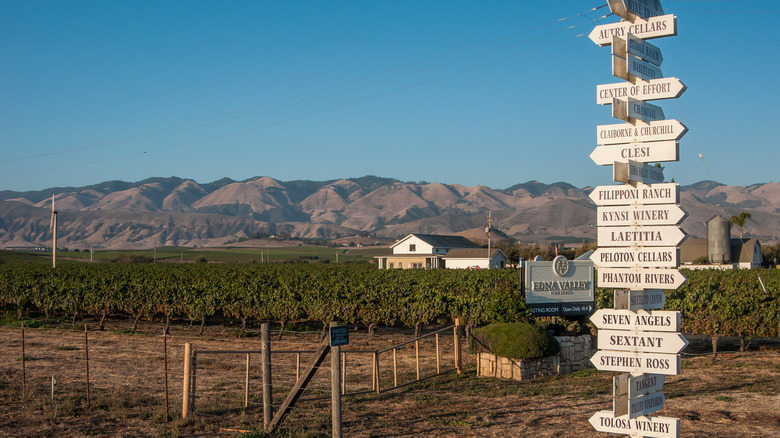These Under-The-Radar Wine Regions Deserve The Same Hype As Napa
While California's Napa Valley is the picture-perfect poster child for quality North American wine, it is hardly the only region in the country that produces good vino. You might not believe it, but it's true. While Napa Valley has a unique climate that helps grow grapes that produce high-quality, top-selling wine, there are so many more wine regions in the country to explore. Any wine-lover would do well to take their discerning palate off the beaten path.
American states come in all shapes, sizes, and climates. It's a country so large and ecologically diverse that numerous types of wine can be produced in all 50 states. Border to border, coast to coast, wine is being made in places you might never have considered, or even heard of. And not necessarily from grapes, either.
We rounded up 12 under-the-radar American wine-making regions that deserve just as much hype as Napa Valley. In this journey from east to west, you can experience just how excellent, diverse, and varied the wine produced in the United States actually is.
The New England Coastal Wine Trail
With its temperate summers and brutal winters, New England does not immediately strike one as being hospitable to growing grapes for wine. However, tucked into the area's little inlets and coves is the Coastal Wine Trail of Southeastern New England. Stretching from Cape Cod in Massachusetts, through the Farm Coast of Rhode Island, and finishing along Long Island Sound in Connecticut are 13 distinct wineries that offer some of the best wines in the region.
Designated as an American Viticultural Area (AVA) in 1984, the wineries along this treasured coast are known to produce some truly crisp whites. Chardonnay, vidal blanc, and riesling are particular favorites, but there are also wineries producing bold reds like pinot noir and cabernet franc. The wineries in this AVA are some of the most well-known in the region, including Truro Vineyards in Massachusetts, Greenvale Vineyards in Rhode Island, and Preston Ridge Vineyard in Connecticut.
If you're interested in venturing a little further north, Bluet is changing the game for Maine blueberry wines. A sparkling blueberry wine that is more Champagne than cough syrup, Bluet has been touted by many publications, including The Boston Globe and Yankee Magazine, as being one of the best wines in New England. And with an emphasis on sourcing blueberries from Maine family farms, drinkers can sip safe in the knowledge they are drinking something local and sustainable.
The Finger Lakes, New York
The Finger Lakes of upstate New York is arguably one of the most scenic areas in the entire northeastern United States. Flanked by woods, hills, waterfalls, charming college towns, and miles of farmland, the Finger Lakes are not only picturesque, but also happen to be one of the top wine producing regions in the entire country. According to Cornell University, the area produced some 54,600 tons of grapes from nearly 9,400 acres in 2017. No Napa Valley, but certainly nothing to shake a stick at!
Three distinct wine trails – Cayuga, Keuka, and Seneca – connect visitors with dozens of independent wineries that cater to every taste. The varieties that thrive in the Finger Lakes are crisp whites like riesling, chardonnay, and chablis. The lesser known but no less flavorful German gewürztraminer also grows well, as do bold reds like pinot noir and cabernet franc.
Seneca Lake, being the largest and most well known of the Finger Lakes, is a visitor's best bet at finding the most quality wines during their trip. With well-known and top-rated vineyards like Atwater Vineyards, Barnstormer Winery, and Hermann J. Wiemer Vineyard, the area is a prime spot for anyone looking to partake in the delicious wines being produced in this scenic corner of New York state.
The Monticello Wine Trail, Virginia
Recently named 2023's Wine Region of the Year by Wine Enthusiast, the Monticello Wine Trail in Virginia is reviving the state's reputation as a competitive player in the wine market. Connecting more than 40 vineyards in central Virginia, the Monticello Wine Trail is celebrated for its distinctive and diverse terroir, unique winemakers, and fascinating history.
Designated as an American Viticultural Area for some 40 years, the region's wine-growing history dates back to the early days of the United States. Thomas Jefferson had a vision for high-quality wines produced in the hills surrounding his Monticello estate. Over the ensuing centuries, his dream became a reality, though he did not live to see it. Jefferson's goal was to grow Old World wines better than the Old World, and some of the Bordeaux and chenin blanc varieties now being grown in central Virginia are said to rival wines from France.
Vineyards of note in this area include Jefferson Vineyards (which is onsite at Monticello), Hazy Mountain Vineyard, Afton Mountain Vineyards, and Vineyard. It would behoove visitors, however, to sample as many wines from this region as possible. If there's a Napa Valley of the east coast, the Monticello AVA is it.
Yadkin Valley, North Carolina
An American Viticultural Area (AVA) is a "grape-growing region with specific geographic or climatic features that distinguish it from the surrounding regions and affect how grapes are grown," according to the Alcohol and Tobacco Tax and Trade Bureau. The purpose of the designation is to help identify specific regions as good for growing wine grapes. The Yadkin Valley AVA in North Carolina was established in 2003, and though younger than many other AVA's, it has made significant inroads in establishing itself as a unique wine-producing region.
Though the area has excelled in growing French-American hybrid varieties since the late 19th century, new wines produced by the 18 area vineyards are making wine lovers put a pin on western North Carolina as a place to visit. Surrounded by the Blue Ridge Mountains and the Yadkin River, the Yadkin Valley AVA produces classic wines like chardonnay, pinot grigio, cabernet sauvignon, and merlot, as well as lesser-known, but no less flavorful, hybrid wines like cynthiana and traminette.
The diversity in background among the winemakers is as rich as the wine itself. Three vineyards are owned and operated by veterans (Haze Gray Vineyards, Carolina Heritage, and Golden Road). Other wineries of note include Stony Knoll Vineyards, owned and operated by the same family since 1896, and Shelton Vineyards, which is the largest family-owned vineyard in the state.
Northern Michigan
You can't get more Michigan than the northerly corner near Traverse City, one of the state's many underrated beach towns. Tucked into a freshwater coastal inlet in the northwestern section of the mitten, the area around Traverse City is home to dozens of high-quality wineries. Just as you wouldn't expect New England to be hospitable to producing great wine, it's difficult to imagine Northern Michigan as being a great place to grow grapes. However, the area's unique terroir and relatively mild weather actually work to its benefit.
Michigan is the fourth-largest producer of grapes in the entire United States. The varieties grown in this region are some of the more well-known European grape varieties, such as cabernet franc, merlot, and cabernet sauvignon. Other area specialities include sparkling rosés and cherry-based wines. Traverse City holds an annual National Cherry Festival to celebrate the area's most widely grown crop.
Thanks to the region's location along Lake Michigan, there's no shortage of waterfront views when it comes to wineries in and around Traverse City. Black Star Farms, Chateau Grand Traverse, and Verterra Winery all come with great wine, food, and tremendous views of that iconic Michigan scenery.
Kentucky wine country
While not an official AVA like some of the other locations on this list, the unofficial Kentucky Wine Trail is still more than worth a gander for anyone who considers themselves to be a wine lover. The trail exists to connect visitors to the state's primary grape growing areas around the cities of Covington, Lexington, and Louisville. The grape varieties vidal blanc and Norton thrive in the soils of these areas, allowing wineries to produce truly wonderful red, white, and rosé wines. There are even some wineries that produce wine made from other fruits and vegetables. Be on the lookout for jalapeno wine while you're traveling.
Kentucky should also be a bucket list item for any self-professed American wine nerds. First Vineyard Winery in Nicholasville holds the honor of being the first (and oldest) continually running commercial winery in the United States. Specializing in chambourcin and concord grapes to produce bold reds, it is a unique, historical wine-drinking experience that no one should pass up.
Other wineries in the area include the award-winning Farmer & Frenchman Winery, Equus Run Vineyards outside of Lexington, and Stonebrook Winery outside of Cincinnati. While you're stopping at vineyards on your Kentucky Wine Trail, don't forget that you're also in bourbon country. It'd be a shame to leave without trying a glass or two.
Texas Hill Country
The characteristics of "wine country" are in part what dictates the states most associated with wine. California, for example, has very European scenery with rolling hills filled with rows of vibrant grapes under a cloudless blue sky. And while Texas may not immediately spring to mind as the kind of place that offers these types of scenes, that's exactly what you're going to find in the excellent wine region of Texas Hill Country.
Over 60 unique wineries dot the hills just north of San Antonio. At over 9 million acres, the Texas Hill Country AVA is the third largest in the United States. Vineyards grow the likes of Sangiovese, merlot, vermentino, Montepulciano, syrah, and tempranillo. A black grape of rioja stock, tempranillo is primarily grown in Spain, but has found a thriving American home in the dry and fertile hills of Texas. It makes for an exceptionally bold red that you can only find in a handful of wine regions in the USA.
Notable wineries include Bending Branch Winery, Pedernales Cellars, Duchman Family Winery, and Pontotoc Vineyard, which specializes in award-winning tempranillos. With the vast amount of wineries to choose from, you could easily get lost in the Texas Hill Country AVA for years and not be remotely upset about it. It may be under-the-radar, but it offers some of the best wines around.
Mesilla Valley, New Mexico
If he hadn't decided to become a meth-making criminal, Walter White could have used his chemistry talents to make it as a winemaker in the Mesilla Valley of New Mexico. Home to some of the oldest grapes on the North American continent, wine has been made in the Mesilla Valley since Spanish settlers first brought grapes to the New World in the 17th century. Located near the border of Mexico, the Mesilla Valley is a less-traveled area of the state that nevertheless produces some truly excellent wines.
The main varieties grown in this arid environment are Spanish and South American varieties that thrive in dry weather. While syrah and zinfandel are common, the mission grape, a red grape that had been used for sacramental wine in its native Spain, is used by some wineries in the Mesilla Valley to make a pale-red, dry wine that bursts with tannins.
Establishments like Rio Grande Winery and Luna Rossa Winery are places discerning wine enthusiasts should check out on a trip to New Mexico. Owing to relatively low tourism, a wine tasting in the Mesilla Valley will be much more laid back and relaxing than a tasting in Sonoma County or Napa Valley. That's reason enough to pay this wine region a visit.
Snake River Valley, Idaho
Much like Texas, Idaho is not a state one commonly associates with quality wine. Idaho encourages visions of scraggly mountains, cowboys, campfires, Hemingway, and fly fishermen. Surprisingly, it's one of the most popular fly fishing destinations, the Snake River, that has created a unique corner in the southern part of the state where wine grapes flourish.
The Snake River AVA encompasses a small section of eastern Oregon, but is mostly known for it's Idaho vineyards. It is home to about a dozen different wineries, all growing a subset of grapes that are not common on liquor store shelves. These include viognier, gewürztraminer, petit verdot, cabernet franc, and malbec. The mostly volcanic soil fed by the crystal clear waters of the Snake River are what have made the terroir of this region so hospitable to these grape varieties.
The vastness of the varieties grown means that there is no signature variety that comes out of the Snake River Valley, but that's okay. It leaves more room for wineries like Sawtooth Winery, Cinder, and Par Terre to experiment and discover the grapes that grow and produce the best wines imaginable for this scenic and unique area of Idaho.
Southern Oregon wine region
The wine regions of Southern Oregon offer an interesting wine growing climate where both warmer and cooler varieties of grapes can survive. Composed of the Rogue Valley, Umpqua Valley, and three more AVA's, Southern Oregon offers an expansive and incredibly diverse wine region that encompasses over 9,200 planted acres of grapes in mixed maritime and volcanic soils. This allows for an incredible amount of grapes to be grown in this region.
In no particular order, the wine produced in Southern Oregon includes pinot noir, pinot gris, syrah, cabernet sauvignon, merlot, viognier, and chardonnay. The Umpqua Valley in particular is home to over 30 wineries nestled among the foothills of the Cascade Range. Meanwhile, the southerly Rouge Valley region has several different wine routes leading to dozens of boutique wineries nestled in the several valleys that make up the Greater Rouge Valley. This includes the Applegate Valley AVA which grows some more Rhone-style wines not commonly seen outside of Vienna, Austria.
The wine in this part of Oregon is very down-to-earth. If you're looking for a place that really dedicates itself to understanding the environment of the grapes and respecting the farmers and vintners who care for them, this is the wine region for you. Notable wineries include Schmidt Family Vineyard and Apricity Vineyard.
Walla Walla Valley, Washington
If there's a wine region in the United States that can easily fool tourists into thinking that they're actually in the Tuscan hills of Italy, it's the Walla Walla Valley in Washington state. Tucked in the southeastern corner of the state at the base of the Columbia Basin, the Walla Walla Valley is a land of rolling hills that seem to stretch into infinity. And thanks to the combination of silt and basalt soils, the Walla Walla Valley has some of the best terroir in the Pacific Northwest.
The Walla Walla AVA was established in 1984, and has been one of the regions that helped establish Washington as a viable wine producer. Primarily a red wine-growing region, some of the most planted varieties include cabernet sauvignon, merlot, and syrah. Other varieties include sangiovese, malbec, pinot noir, cabernet franc, and grenache.
Split into distinctive AVA areas, the Walla Walla Valley has too many notable wineries to count. Some of the distinctive ones include Kinhaven Winery, Three Rivers Winery, and Echolands Winery. The AVA also dips into northeastern Oregon, where you can sip on wines from Watermill Winery and Horsepower Vineyards.
Edna Valley, California
No USA wine tour would be complete without a visit to California. However, you don't have to visit Napa Valley to find fine wines. Thanks to the state's enormous size and ecological diversity, there are many wine-friendly nooks and crannies throughout California that are just begging to be explored. One such corner is the Edna Valley.
One of south-central California's hidden gems, Edna Valley is located along the coast and is home to some beautiful rolling hills and truly excellent terroir. Vineyards like Tolosa Winery and Saucelito Canyon Vineyards produce top-quality sauvignon blanc, pinot noir, sirah, and voininger. Cadre Winery not only boasts some fantastic bottle artwork, but also an award-winning grüner veltliner that is not commonly seen in California.
While this list is not exhaustive, it should provide you with an idea of just how diverse and amazing US wine offerings really are. Whether you're relaxing at a coastal vineyard or gazing out over the hills, you are sure to find some truly excellent wine in the less-traveled wine corners of the country.

